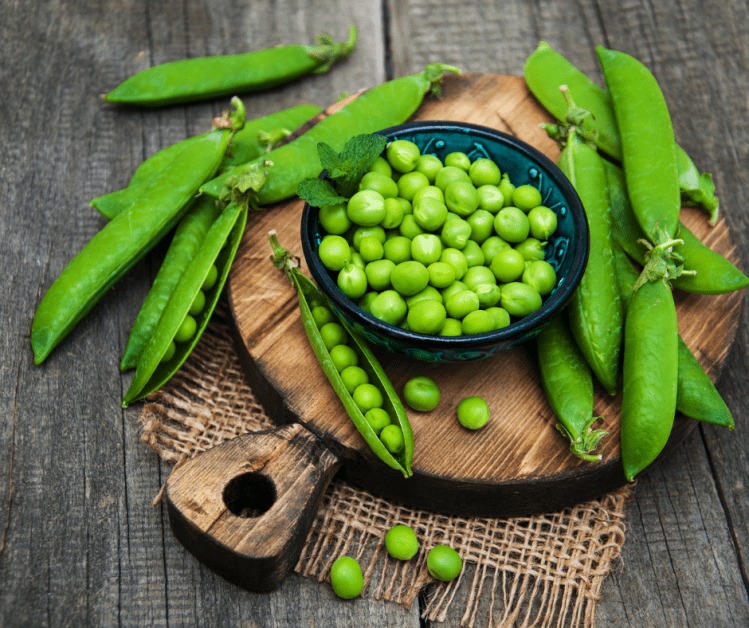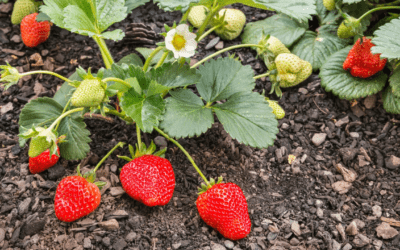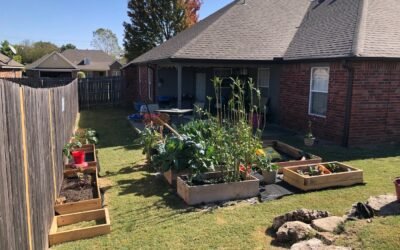
How To Grow Peas Organically In The Garden
Peas are a versatile and nutritious addition to any organic vegetable garden. They are packed with vitamins, minerals, and fiber, making them a popular choice for both home gardeners and professional farmers. Growing peas organically ensures that you’ll have a supply of fresh, chemical-free peas that are not only delicious but also environmentally friendly. This complete guide will walk you through the step-by-step process of successfully growing organic peas in your vegetable garden.
Watch our video to see how we pre-sprout our seeds. We also discuss how to choose the right variety.
Choosing The Right Pea Variety:
There are various pea varieties to choose from, each with unique characteristics and growing requirements. Common types include shelling peas, snap peas, and snow peas. Choose a variety that suits your preferences and climate. For an organic garden, it’s best to opt for heirloom or open-pollinated varieties.

Planning and Preparing the Garden:
Location: Select a sunny spot in your garden that receives at least 6-8 hours of sunlight per day. Peas thrive in well-drained soil with a slightly acidic to neutral pH (6.0-7.5). Soil Preparation: Prior to planting, enrich the soil with organic matter such as compost or well-rotted manure. This enhances soil fertility, water retention, and drainage. Bed Preparation: Create raised beds or rows for better drainage. Avoid planting peas in areas that are prone to waterlogging, as excessive moisture can lead to diseases like root rot.
Planting Peas:
Timing: Peas are a cool-season crop, meaning they prefer to grow in cooler temperatures. Depending on your climate, plant peas as early as late winter to early spring for spring harvest or in late summer for a fall harvest. Sowing Seeds: Plant pea seeds directly in the garden. Space rows about 18-24 inches apart to allow air circulation and easy access for harvesting. Planting Depth: Plant seeds about 1-2 inches deep, placing them about 2-3 inches apart. Cover the seeds with soil and pat gently. Support Structures: As your pea plants grow, they will need support to prevent them from falling over. Install trellises, stakes, or other support structures at the time of planting to avoid damaging the delicate root system later.
Care and Maintenance:
Watering: Keep the soil consistently moist but not waterlogged. Water at the base of the plants to avoid wetting the foliage, which can lead to disease. A soaker hose or drip irrigation system works well for maintaining proper moisture levels. Mulching: Apply a layer of organic mulch, such as straw or leaves, around the base of the plants to retain soil moisture and suppress weed growth. Thinning: Once the pea seedlings have sprouted and are a few inches tall, thin them to ensure proper spacing. This improves air circulation and reduces the risk of disease. Weeding: Regularly weed your pea bed to minimize competition for nutrients and water. Hand-pulling weeds is recommended in an organic garden. Fertilization: Peas are generally light feeders, but a balanced organic fertilizer can be applied when the plants start producing flowers. Avoid excessive nitrogen fertilizers, as they can lead to excessive foliage growth and fewer pods.
Pest and Disease Management:
Companion Planting: Planting aromatic herbs like mint, rosemary, or thyme nearby can help repel certain pests. Marigolds are also known to deter pests. Hand Picking: Regularly inspect your pea plants for pests like aphids, caterpillars, and beetles. Handpick these insects and remove them from the garden. Neem Oil Spray: Use neem oil or insecticidal soap to control pests. These organic options are effective against many common garden pests. Crop Rotation: Avoid planting peas in the same location year after year to reduce the risk of soil-borne diseases. Practice a 3-4 year crop rotation plan. Disease Prevention: Provide adequate spacing between plants to improve air circulation and reduce the risk of fungal diseases. Avoid overhead watering to prevent moisture on foliage.

Harvesting Peas:
Timing: Harvest times vary depending on the pea variety. Shelling peas are ready when the pods are plump, while snap peas and snow peas should be harvested when the pods are flat and the peas are tender. Harvesting Technique: Use two hands to gently hold the vine and the pod. Use your thumb and forefinger to snap the pod off the plant. Regular Harvesting: Regularly harvest mature pods to encourage continuous production. Leaving overripe pods on the vine can signal the plant to stop producing. Storing Peas: Peas are best enjoyed fresh, but if you have an abundant harvest, you can blanch and freeze them for later use.
Post-Harvest Care:
Composting: After harvesting, remove spent pea plants and add them to your compost pile. This will help enrich your compost with green material. Soil Rejuvenation: As part of your crop rotation plan, replenish the soil with compost and organic matter before planting your next crop.
Conclusion: Growing organic peas in your vegetable garden can be a rewarding and environmentally friendly endeavor. By following this comprehensive guide, you’ll be well-equipped to nurture healthy pea plants, enjoy a bountiful harvest, and contribute to the sustainability of your garden. Remember that successful organic gardening requires patience, observation, and a commitment to working in harmony with nature to create a thriving and productive garden ecosystem.

Variety Details:
Shelling Peas:
Characteristics: Shelling peas, also known as garden peas or English peas, are the traditional pea variety. They are characterized by their round, plump seeds encased in inedible pods. To enjoy the sweet and tender peas inside, you must shell or remove them from the pod.
Examples of Shelling Pea Varieties:
- Green Arrow (Pisum sativum ‘Green Arrow’): Green Arrow peas are a classic shelling pea variety known for their high yields of sweet, bright green peas. They have a compact growth habit and are suitable for both home gardens and commercial production.
- Wando (Pisum sativum ‘Wando’): Wando peas are a popular choice for early spring planting. They produce large, sweet peas in pods that are easy to shell. This variety is known for its resistance to heat, allowing for extended harvests.
Best Uses: Shelling peas are best suited for dishes where the tender, sweet peas are the star of the show. They are commonly used in dishes like pea soup, risotto, and as a side dish when simply steamed or sautéed.
Snap Peas:
Characteristics: Snap peas, also called sugar snap peas, are a hybrid of shelling peas and snow peas. They have edible pods that are crisp and sweet. Unlike shelling peas, the entire pod, including the peas, can be eaten.
Examples of Snap Pea Varieties:
- Sugar Ann (Pisum sativum var. macrocarpon ‘Sugar Ann’): Sugar Ann snap peas are an early-maturing variety that produces sweet, tender pods. They are well-suited for small gardens or containers due to their compact growth habit.
- Super Sugar Snap (Pisum sativum var. macrocarpon ‘Super Sugar Snap’): This snap pea variety is known for its large, juicy pods and excellent flavor. It is a vigorous grower that requires support as it can reach up to six feet in height.
Best Uses: Snap peas are delightful for snacking, adding to salads, stir-frying, or as a crunchy addition to vegetable platters. They are also suitable for cooked dishes where you want to maintain the pod’s crisp texture.
Snow Peas:
Characteristics: Snow peas, also known as Chinese pea pods, are distinguished by their flat, edible pods and small, underdeveloped peas inside. Both the pods and peas are tender and are typically harvested before the peas mature.
Examples of Snow Pea Varieties:
- Oregon Sugar Pod II (Pisum sativum var. macrocarpon ‘Oregon Sugar Pod II’): Oregon Sugar Pod II is a widely grown snow pea variety known for its sweet and tender pods. It produces uniform, flat pods that are perfect for stir-frying and salads.
- Dwarf Gray Sugar (Pisum sativum var. macrocarpon ‘Dwarf Gray Sugar’): This snow pea variety is compact and well-suited for small gardens or container growing. It offers pale green, flat pods with a mild, sweet flavor.
Best Uses: Snow peas are ideal for stir-frying, adding a crisp texture to Asian dishes, or as a raw snack. They are often used in dishes like chicken stir-fry or vegetable medleys.
The choice of which pea variety to grow depends on your culinary preferences and how you plan to use them in your dishes. Gardeners often grow a combination of these pea types to enjoy a variety of flavors and textures in their meals while taking advantage of their unique characteristics.
Let me know in the comments, have you grown peas in your garden? What’s your favorite variety?




0 Comments
Trackbacks/Pingbacks